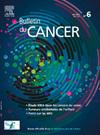Apports et limites de l’ADN tumoral circulant dans le cancer du sein
IF 0.8
4区 医学
Q4 ONCOLOGY
引用次数: 0
Abstract
La détection de l’ADN tumoral circulant (ADNtc) a connu des avancées majeures ces dernières années en cancérologie. L’ADNtc permet de nombreuses applications, notamment la détection de mutations théranostiques, la surveillance des rechutes tumorales et le suivi de l’efficacité des traitements. Dans le cancer du sein, plusieurs tests basés sur l’ADNtc pour la détection des rechutes tumorales au cours du suivi sont en cours de validation, et certains sont déjà disponibles dans certains pays, comme les États-Unis. Dans les cancers du sein métastatiques, le taux d’ADNtc ainsi que sa dynamique en cours de traitement ont une valeur pronostique. L’essai PADA1 a montré qu’une adaptation thérapeutique basée sur la détection d’un sous-clone circulant via l’ADNtc était faisable et potentiellement bénéfique pour les patientes. Dans cette revue, nous décrirons les méthodes de détection de l’ADNtc et nous discuterons des bénéfices potentiels de cette technologie pour le suivi et la prise en charge du cancer du sein dans les différentes situations cliniques.
The detection of circulating tumor DNA (ctDNA) has made significant advances in oncology in recent years. ctDNA offers a range of applications, including the identification of theranostic mutations, monitoring of tumor recurrence, and assessing treatment efficacy. In breast cancer, several ctDNA-based tests for detecting relapse during follow-up are currently under validation, with some already available in countries like the United States. In metastatic breast cancer, ctDNA levels and their dynamics during treatment have prognostic value. The PADA-1 trial demonstrated that a therapeutic adaptation based on the detection of a circulating subclone via circulating tumor DNA (ctDNA) was feasible and potentially beneficial for patients. This review will explore the methods for ctDNA detection and discuss the potential benefits of incorporating this technology into breast cancer monitoring and management across various clinical scenarios.
[循环肿瘤DNA在乳腺癌中的益处和局限性]。
近年来,循环肿瘤DNA (ctDNA)的检测在肿瘤学领域取得了重大进展。ctDNA提供了一系列的应用,包括治疗突变的识别,肿瘤复发的监测,和评估治疗效果。在乳腺癌方面,目前正在验证几种基于ctdna的检测方法,用于检测随访期间的复发,其中一些已经在美国等国家可用。在转移性乳腺癌中,ctDNA水平及其治疗过程中的动态具有预后价值。PADA-1试验表明,通过循环肿瘤DNA (ctDNA)检测循环亚克隆的治疗适应性是可行的,对患者可能有益。本文将探讨ctDNA检测的方法,并讨论将该技术纳入乳腺癌监测和管理的潜在益处。
本文章由计算机程序翻译,如有差异,请以英文原文为准。
求助全文
约1分钟内获得全文
求助全文
来源期刊

Bulletin Du Cancer
医学-肿瘤学
CiteScore
1.90
自引率
16.70%
发文量
224
审稿时长
37 days
期刊介绍:
Without doubt, the ''Bulletin du Cancer'' is the French language publication of reference in the field of cancerology. Official organ of the French Society of Cancer, this journal covers all the information available, whether in the form of original articles or review articles, but also clinical cases and letters to the editor, including various disciplines as onco-hematology, solids tumors, medical oncology, pharmacology, epidemiology, biology as well as fundamental research in cancerology. The journal proposes a clinical and therapeutic approach of high scientific standard and regular updates in knowledge are thus made possible. Articles can be submitted in French or English.
 求助内容:
求助内容: 应助结果提醒方式:
应助结果提醒方式:


